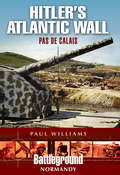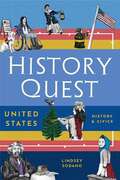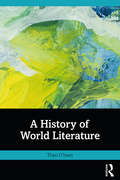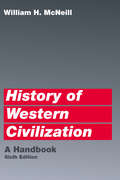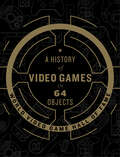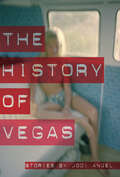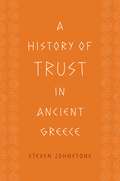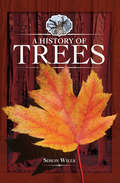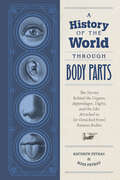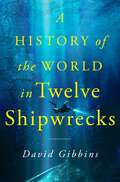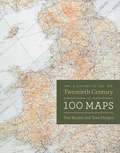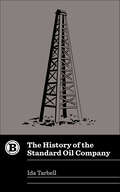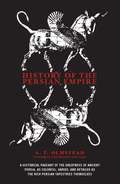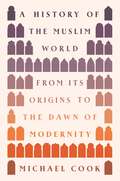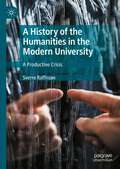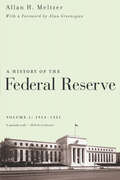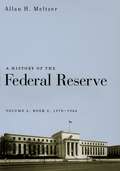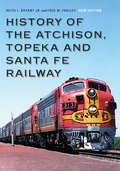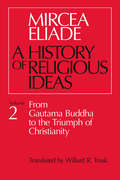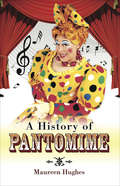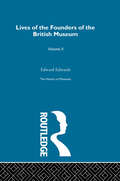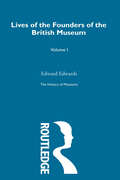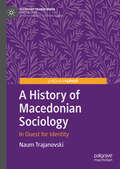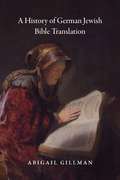- Table View
- List View
Hitler's Atlantic Wall: Pas de Calais (Battleground Normandy)
by Paul WilliamsThis well-illustrated book describes the massive effort that the occupying Nazi forces put into the construction of the Eastern section of the Atlantic Wall. While the D-Day invasion was unaffected by the fortifications in this area, they still posed a significant threat. This came from the mighty gun batteries (such as Batteries Todt and Lindemann) that threatened Channel shipping and the South Coast of England, and, while isolated from the main Allied advance, the Festung ports of Calais, Boulogne and Dunkirk were denied to Allied use. This was of major strategic significance as the lines of supply were becoming ever longer and more vulnerable.Using rare archive material, this book takes the reader on a fascinating journey along the coast that Hitler was wrongly convinced would be the site of the Allied landings. Hitlers Atlantic Wall Pas de Calais tells the history of how and why the giant batteries were built, the origins of their weaponry and the ingenious engineering and military operations that defeated them finally.
History Quest: United States
by Lindsey SodanoHistory United States is a secular homeschool curriculum covering the history and civics of the United States from the 1500s to the early 21st century. Because it is secular, the text presents religious beliefs from this period not as factual accounts, but as relevant sources and perspectives to be considered through a historical lens. Designed as a read-aloud for upper elementary-age children, an independent read for older students, or a journey of thrilling stories to be shared during family story time, this main text of the History United States curriculum presents an immersive study of U.S. history and civics in an engaging and memorable format. Used alongside the History United States Study Guide and other recommended resources, your students will learn about the ideas, conflicts, inventions, and individuals that shaped the United States (and the world) and take their first step in a life-long quest to explore and appreciate history.
A History of World Literature
by Theo D'haenA History of World Literature is a fully revised and expanded edition of The Routledge Concise History of World Literature (2012). This remarkably broad and informative book offers an introduction to “world literature.”Tracing the term from its earliest roots and situating it within a number of relevant contexts from postcolonialism, decoloniality, ecocriticism, and book circulation, Theo D’haen in ten tightly-argued but richly-detailed chapters examines: the return of the term “world literature” and its changing meaning; Goethe’s concept of Weltliteratur and how this relates to current debates; theories and theorists who have had an impact on world literature; and how world literature is taught around the world. By examining how world literature is studied around the globe, this book is the ideal guide to an increasingly popular and important term in literary studies. It is accessible and engaging and will be invaluable to students of world literature, comparative literature, translation, postcolonial and decoloniality studies, and materialist approaches, and to anyone with an interest in these or related topics.
History of Western Civilization: A Handbook
by William H. McNeillRenowned historian William H. McNeil provides a brilliant narrative chronology of the development of Western civilization, representing its socio-political as well as cultural aspects. This sixth edition includes new material for the twentieth-century period and completely revised bibliographies. An invaluable tool for the study of Western civilization, the Handbook is an essential complement to readings in primary and secondary sources such as those in the nine-volume University of Chicago Readings in Western Civilization.
A History of Video Games in 64 Objects
by World Video Game Hall of FameInspired by the groundbreaking A History of the World in 100 Objects, this book draws on the unique collections of The Strong museum in Rochester, New York, to chronicle the evolution of video games, from Pong to first-person shooters, told through the stories of dozens of objects essential to the field’s creation and development.Drawing on the World Video Game Hall of Fame’s unmatched collection of video game artifacts, this fascinating history offers an expansive look at the development of one of the most popular and influential activities of the modern world: video gaming.Sixty-four unique objects tell the story of the video game from inception to today. Pithy, in-depth essays and photographs examine each object’s significance to video game play—what it has contributed to the history of gaming—as well as the greater culture.A History of Video Games in 64 Objects explains how the video game has transformed over time. Inside, you’ll find a wide range of intriguing topics, including:The first edition of Dungeons & Dragons—the ancestor of computer role-playing gamesThe Oregon Trail and the development of educational gamingThe Atari 2600 and the beginning of the console revolutionA World of Warcraft server blade and massively multiplayer online gamesMinecraft—the backlash against the studio systemThe rise of women in gaming represented by pioneering American video game designers Carol Shaw and Roberta Williams’ game development materialsThe prototype Skylanders Portal of Power that spawned the Toys-to-Life video game phenomenon and shook up the marketplaceAnd so much more!A visual panorama of unforgettable anecdotes and factoids, A History of Video Games in 64 Objects is a treasure trove for gamers and pop culture fans. Let the gaming begin!
The History of Vegas: Stories
by Jodi AngelTrouble. From the first page of each of the edgy and unrelentingly intense stories in this debut collection, the teenaged characters are headed for big trouble. The adult world has mostly failed them, and they find themselves entering into highly charged situations where they make their own rules, with misguided understanding of the consequences. The stories burn hot and fast, providing searing insights into their world of sex, drugs, drinking, violence, and accidental grace, played out in small, tough towns. Written with raw directness and understanding that makes these nine stories impossible to forget, The History of Vegas announces an exciting, fresh talent with the impact of Mary Gaitskill, Mary Karr, and Jayne Anne Phillips.
A History of Trust in Ancient Greece
by Steven JohnstoneAn enormous amount of literature exists on Greek law, economics, and political philosophy. Yet no one has written a history of trust, one of the most fundamental aspects of social and economic interaction in the ancient world. In this fresh look at antiquity, Steven Johnstone explores the way democracy and markets flourished in ancient Greece not so much through personal relationships as through trust in abstract systems—including money, standardized measurement, rhetoric, and haggling.Focusing on markets and democratic politics, Johnstone draws on speeches given in Athenian courts, histories of Athenian democracy, comic writings, and laws inscribed on stone to examine how these systems worked. He analyzes their potentials and limitations and how the Greeks understood and critiqued them. In providing the first comprehensive account of these pervasive and crucial systems, A History of Trust in Ancient Greece links Greek political, economic, social, and intellectual history in new ways and challenges contemporary analyses of trust and civil society.
A History of Trees
by Simon WillsMake Arbor Day every day with little known and intriguing facts about the plants that populate our forests, give us shade, and clean our air. Have you ever wondered how trees got their names? What did our ancestors think about trees, and how were they used in the past? This fascinating book will answer many of your questions, but also reveal interesting stories that are not widely known. For example, the nut from which tree was predicted to pay off the UK&’s national debt? Or why is Europe&’s most popular pear called the &“conference&”? Simon Wills tells the history of twenty-eight common trees in an engaging and entertaining way, and every chapter is illustrated with his photographs. Find out why the London plane tree is so frequently planted in our cities, and how our forebears were in awe of the magical properties of hawthorn. Where is Britain&’s largest conker tree? Which tree was believed to protect you against both lightning and witchcraft? The use of bay tree leaves as a sign of victory by athletes in ancient Greece led to them being subsequently adopted by many others—from Roman emperors to the Royal Marines. But why were willow trees associated with Alexander Pope, Napoleon Bonaparte, and Samuel Johnson? Why did Queen Anne pay a large sum for a cutting from a walnut tree in Somerset? Discover the answers to these and many other intriguing tales within the pages of this highly engrossing book.
A History of the World Through Body Parts: The Stories Behind the Organs, Appendages, Digits, and the Like Attached to (or Detached from) Famous Bodies
by Kathy Petras Ross PetrasA grab bag of historic spleens, chins, and more, this is your ultimate literary dissection of body parts throughout history!From famous craniums to prominent breasts, ancient spleens and bound feet, this book will bring history to life in a whole new way. With their inimitable wit and probing intelligence, authors Kathy and Ross Petras look at the role the human body has played throughout history as each individual part becomes a jumping-off point for a wider look at the times. In far-ranging, quirky-yet-interrelated stories, learn about Charles II of Spain's jaw and the repercussions of inbreeding, what Anne Boleyn's heart says about the Crusades and the trend of dispersed burials, and what can be learned about the Aztecs through Moctezuma's pierced lip. A History of the World Through Body Parts is packed with fascinating little-known historical facts and anecdotes that will entertain, enlighten, and delight even the most well-read history buff.BESTSELLING AUTHORS: Kathy and Ross Petras have authored the New York Times bestseller You're Saying It Wrong and the hit calendar The 365 Stupidest Things Ever Said, now in its 24th year with over 4.8 million copies sold!ENGAGING CONTENT: Packed with rich material told with a lively and humorous voice, take a trip through history in this unique, exciting way.QUIRKY HISTORY FANS REJOICE!: For fans of The Disappearing Spoon, Wicked Plants, The Violinist's Thumb, The Sawbones Book and Strange Histories!Perfect for:• History buffs and pop history fans• Father's Day, birthday, and holiday shoppers
A History of the World in Twelve Shipwrecks
by David GibbinsFrom renowned underwater archaeologist David Gibbins comes an exciting and rich narrative of human history told through the archaeological discoveries of twelve shipwrecks across time.The Viking warship of King Cnut the Great. Henry VIII's the Mary Rose. Captain John Franklin's doomed HMS Terror. The SS Gairsoppa, destroyed by a Nazi U-boat in the Atlantic during World War II.Since we first set sail on the open sea, ships and their wrecks have been an inevitable part of human history. Archaeologists have made spectacular discoveries excavating these sunken ships, their protective underwater cocoon keeping evidence of past civilizations preserved. Now, for the first time, world renowned maritime archeologist David Gibbins ties together the stories of some of the most significant shipwrecks in time to form a single overarching narrative of world history.A History of the World in Twelve Shipwrecks is not just the story of those ships, the people who sailed on them, and the cargo and treasure they carried, but also the story of the spread of people, religion, and ideas around the world; it is a story of colonialism, migration, and the indominable human spirit that continues today. From the glittering Bronze Age, to the world of Caesar's Rome, through the era of the Vikings, to the exploration of the Arctic, Gibbins uses shipwrecks to tell all.Drawing on decades of experience excavating shipwrecks around the world, Gibbins reveals the riches beneath the waves and shows us how the treasures found there can be a porthole to the past that tell a new story about the world and its underwater secrets.
A History of the Twentieth Century in 100 Maps
by Tom Harper Tim BryarsThe twentieth century was a golden age of mapmaking, an era of cartographic boom. Maps proliferated and permeated almost every aspect of daily life, not only chronicling geography and history but also charting and conveying myriad political and social agendas. Here Tim Bryars and Tom Harper select one hundred maps from the millions printed, drawn, or otherwise constructed during the twentieth century and recount through them a narrative of the century’s key events and developments. As Bryars and Harper reveal, maps make ideal narrators, and the maps in this book tell the story of the 1900s—which saw two world wars, the Great Depression, the Swinging Sixties, the Cold War, feminism, leisure, and the Internet. Several of the maps have already gained recognition for their historical significance—for example, Harry Beck’s iconic London Underground map—but the majority of maps on these pages have rarely, if ever, been seen in print since they first appeared. There are maps that were printed on handkerchiefs and on the endpapers of books; maps that were used in advertising or propaganda; maps that were strictly official and those that were entirely commercial; maps that were printed by the thousand, and highly specialist maps issued in editions of just a few dozen; maps that were envisaged as permanent keepsakes of major events, and maps that were relevant for a matter of hours or days. As much a pleasure to view as it is to read, A History of the Twentieth Century in 100 Maps celebrates the visual variety of twentieth century maps and the hilarious, shocking, or poignant narratives of the individuals and institutions caught up in their production and use.
The History of the Standard Oil Company (Belt Revivals)
by Ida TarbellPart of Belt's Revivals Series, a classic of muckraking journalism with a new introduction by Elizabeth Catte, author of What You Are Getting Wrong About Appalachia and Pure America . Cleveland oil tycoon Jo
History of the Persian Empire
by A. T. OlmsteadOut of a lifetime of study of the ancient Near East, Professor Olmstead has gathered previously unknown material into the story of the life, times, and thought of the Persians, told for the first time from the Persian rather than the traditional Greek point of view. "The fullest and most reliable presentation of the history of the Persian Empire in existence."—M. Rostovtzeff
A History of the Muslim World: From Its Origins to the Dawn of Modernity
by Michael A. CookA panoramic history of the Muslim world from the age of the Prophet Muḥammad to the birth of the modern eraThis book describes and explains the major events, personalities, conflicts, and convergences that have shaped the history of the Muslim world. The body of the book takes readers from the origins of Islam to the eve of the nineteenth century, and an epilogue continues the story to the present day. Michael Cook thus provides a broad history of a civilization remarkable for both its unity and diversity.After setting the scene in the Middle East of late antiquity, the book depicts the rise of Islam as one of the great black swan events of history. It continues with the spectacular rise of the Caliphate, an empire that by the time it broke up had nurtured the formation of a new civilization. It then goes on to cover the diverse histories of all the major regions of the Muslim world, providing a wide-ranging account of the key military, political, and cultural developments that accompanied the eastward and westward spread of Islam from the Middle East to the shores of the Atlantic and the Pacific.At the same time, A History of the Muslim World contains numerous primary-source quotations that expose the reader to a variety of acutely insightful voices from the Muslim past.
A History of the Humanities in the Modern University: A Productive Crisis
by Sverre RaffnsøeThis book challenges commonplace assertions that the humanities are presently undergoing a severe crisis as a result of a longstanding decline. Rather than hearkening to the widespread, reactive call for a last-ditch defense of the humanities under attack from an ungracious world, this book fundamentally reverses the perspective and makes a plea for a different, affirmative approach. It contends that the humanities have incessantly arrived at critical turning points since they were first constituted in a form that remains recognizable today and assumed a leading role in knowledge organization with the establishment of the modern university around 1800. Assuming a historical perspective, the monograph takes the human sciences back to their rightful place in the family tree of sciences and gives due recognition to their continuously decisive role in the production of new knowledge and the creation of new fields of knowledge. Situating the ongoing gemmation of the humanities in a broader context, this monograph also offers an encompassing introduction to the over-all development of knowledge in the last two hundred years.
A History of the Federal Reserve: 1913–1951
by Allan H. MeltzerAllan H. Meltzer's monumental history of the Federal Reserve System tells the story of one of America's most influential but least understood public institutions. This first volume covers the period from the Federal Reserve's founding in 1913 through the Treasury-Federal Reserve Accord of 1951, which marked the beginning of a larger and greatly changed institution. To understand why the Federal Reserve acted as it did at key points in its history, Meltzer draws on meeting minutes, correspondence, and other internal documents (many made public only during the 1970s) to trace the reasoning behind its policy decisions. He explains, for instance, why the Federal Reserve remained passive throughout most of the economic decline that led to the Great Depression, and how the Board's actions helped to produce the deep recession of 1937 and 1938. He also highlights the impact on the institution of individuals such as Benjamin Strong, governor of the Federal Reserve Bank of New York in the 1920s, who played a key role in the adoption of a more active monetary policy by the Federal Reserve. Meltzer also examines the influence the Federal Reserve has had on international affairs, from attempts to build a new international financial system in the 1920s to the Bretton Woods Agreement of 1944 that established the International Monetary Fund and the World Bank, and the failure of the London Economic Conference of 1933. Written by one of the world's leading economists, this magisterial biography of the Federal Reserve and the people who helped shape it will interest economists, central bankers, historians, political scientists, policymakers, and anyone seeking a deep understanding of the institution that controls America's purse strings. "It was 'an unprecedented orgy of extravagance, a mania for speculation, overextended business in nearly all lines and in every section of the country.' An Alan Greenspan rumination about the irrational exuberance of the late 1990s? Try the 1920 annual report of the board of governors of the Federal Reserve. . . . To understand why the Fed acted as it did—at these critical moments and many others—would require years of study, poring over letters, the minutes of meetings and internal Fed documents. Such a task would naturally deter most scholars of economic history but not, thank goodness, Allan Meltzer."—Wall Street Journal "A seminal work that anyone interested in the inner workings of the U. S. central bank should read. A work that scholars will mine for years to come."—John M. Berry, Washington Post "An exceptionally clear story about why, as the ideas that actually informed policy evolved, things sometimes went well and sometimes went badly. . . . One can only hope that we do not have to wait too long for the second installment."—David Laidler, Journal of Economic Literature "A thorough narrative history of a high order. Meltzer's analysis is persuasive and acute. His work will stand for a generation as the benchmark history of the world's most powerful economic institution. It is an impressive, even awe-inspiring achievement."—Sir Howard Davies, Times Higher Education Supplement
A History of the Federal Reserve: Book 2, 1970–1986
by Allan H. MeltzerAllan H. Meltzer’s critically acclaimed history of the Federal Reserve is the most ambitious, most intensive, and most revealing investigation of the subject ever conducted. Its first volume, published to widespread critical acclaim in 2003, spanned the period from the institution’s founding in 1913 to the restoration of its independence in 1951. This two-part second volume of the history chronicles the evolution and development of this institution from the Treasury–Federal Reserve accord in 1951 to the mid-1980s, when the great inflation ended. It reveals the inner workings of the Fed during a period of rapid and extensive change. An epilogue discusses the role of the Fed in resolving our current economic crisis and the needed reforms of the financial system.In rich detail, drawing on the Federal Reserve’s own documents, Meltzer traces the relation between its decisions and economic and monetary theory, its experience as an institution independent of politics, and its role in tempering inflation. He explains, for example, how the Federal Reserve’s independence was often compromised by the active policy-making roles of Congress, the Treasury Department, different presidents, and even White House staff, who often pressured the bank to take a short-term view of its responsibilities. With an eye on the present, Meltzer also offers solutions for improving the Federal Reserve, arguing that as a regulator of financial firms and lender of last resort, it should focus more attention on incentives for reform, medium-term consequences, and rule-like behavior for mitigating financial crises. Less attention should be paid, he contends, to command and control of the markets and the noise of quarterly data.At a time when the United States finds itself in an unprecedented financial crisis, Meltzer’s fascinating history will be the source of record for scholars and policy makers navigating an uncertain economic future.
History of the Atchison, Topeka and Santa Fe Railway
by Fred W. Frailey Keith L. Bryant Jr.Cyrus K. Holliday envisioned a railroad that would run from Kansas to the Pacific, increasing the commerce and prosperity of the nation. With farsighted investors and shrewd management, the Atchison, Topeka and Santa Fe Railway grew from Holliday&’s idea into a model of the modern, rapid, and efficient railroad. There were many growing pains early on, including rustlers, thieves, and desperadoes as well as the nineteenth century&’s economic and climatic hardships. The railroad eventually extended from Chicago to San Francisco, with substantial holdings in oil fields, timber land, uranium mines, pipelines, and real estate. This is the first comprehensive history of the iconic Atchison, Topeka and Santa Fe Railway, from its birth in 1859 to its termination in 1996. This volume discusses the construction and operation of the railway, the strategies of its leaders, the evolution of its locomotive fleet, and its famed passenger service with partner Fred Harvey. The vast changes within the nation&’s railway system led to a merger with the Burlington Northern and the creation of the BNSF Railway. An iconic railroad, the Santa Fe at its peak operated thirteen thousand miles of routes and served the southwestern region of the nation with the corporate slogan &“Santa Fe All the Way.&” This new edition covers almost twenty-five more years of history, including the merger of the Santa Fe and Burlington Northern railroads and new material on labor, minorities, and women on the carrier along with new and updated maps and photographs.
A History of Religious Ideas, Volume 2: From Gautama Buddha to the Triumph of Christianity
by Mircea EliadeIn volume 2 of this monumental work, Mircea Eliade continues his magisterial progress through the history of religious ideas. The religions of ancient China, Brahmanism and Hinduism, Buddha and his contemporaries, Roman religion, Celtic and German religions, Judaism, the Hellenistic period, the Iranian syntheses, and the birth of Christianity—all are encompassed in this volume.
A History of Pantomime
by Maureen HughesEach Christmas entire families in the UK troop off to see, what one could almost say is 'the obligatory'. annual entertainment, known as Pantomime. It is a traditional, seasonal way of life for the British envied the world over, and one which only the British seem to understand! Pantomime serves both to entertain and to introduce each new generation to the joys of theatre in the most unique of ways, for this is not a type of theatre one merely watches, but one in which the audience participate often in the most seemingly boisterous and bizarre of ways. The whole experience is steeped in tradition, traditions which only the British seem to understand, which is probably why we are proud to call it a 'British Experience.'In A History of Pantomime Maureen Hughes takes a brief look at the history of Pantomime as well as taking a humorous look at some of the above mentioned traditions; she also gives a synopsis of each of the well-known Pantomimes whilst exploring the eccentric world of the characters who appear in them. There is also a short piece on just some of the most well-known and loved of the actors who each Christmas take on the part of Pantomime Dames across the UK, as well as a look at others who have contributed to this magical world of fun and eccentricity. It is thought by some to be frivolous and pointless piece of theatre, but a browse through this informative book and you will soon find that Pantomime is an art form all of its own, requiring the most dedicated and talented of actors/actresses who are prepared to honour and perpetuate this wonderful tradition as it is passed down from one generation to the next.As seen in The Telegraph and the Sunday Post (Glasgow).
The History of Museums Vol 2
by Edward EdwardsMuseums and collecting is now a major area of cultural studies. This selected group of key texts opens the investigation and appreciation of museum history. Edward Edwards, chief pioneer of municipal public libraries, chronicles the founders and early donors to the British Museum. Greenwood and Murray provide informative pictures of the early history of the museum movement. Sir William Flower, Director of the British Museum (Natural History), takes a pioneering philosophical approach to the sphere of natural history in relation to museums. Similarly, Acland and Ruskin discuss and explore the relationships of art and architecture to museums.
The History of Museums Vol 1: With Notices Of Its Chief Augmentors And Other Benefactors, 1570-1870
by Edward EdwardsMuseums and collecting is now a major area of cultural studies. This selected group of key texts opens the investigation and appreciation of museum history. Edward Edwards, chief pioneer of municipal public libraries, chronicles the founders and early donors to the British Museum. Greenwood and Murray provide informative pictures of the early history of the museum movement. Sir William Flower, Director of the British Museum (Natural History), takes a pioneering philosophical approach to the sphere of natural history in relation to museums. Similarly, Acland and Ruskin discuss and explore the relationships of art and architecture to museums.
History of Modern Tamil Literature Volume 1
by Neela Padmanabhan Sirpi Balasubramaniamஇதுவரை வெளிவந்துள்ள இலக்கிய வரலாறுகள் எல்லாம் தனி ஒருவர் அல்லது இருவரால் எழுதப்பட்டதாக இருக்க இந்தப் புதிய தமிழ் இலக்கிய வரலாற்றில் ஒவ்வொரு கட்டுரையும் தனித்தனி அறிஞரால் எழுதப்பட்டிருப்பது தனிச்சிறப்பாகும். கட்டுரைகளின் தரம் சிறப்பானதென்றாலும் பல்வேறு தனித்த பார்வைகளைத் தத்தம் கட்டுரைகளில் கட்டுரையாளர்கள் புலப்படுத்தியுள்ளனர். மரபு நோக்குள்ள கட்டுரைகளைப் போலவே திறனாய்வு நோக்குள்ள கட்டுரைகளும் இடம் பெற்றுள்ளன. வகுத்தும் தொகுத்தும் சொல்லும் பாங்கும் உண்டு. நவீனத்துவ, சமூக அணுகுமுறைக் கட்டுரைகளும் உண்டு. இதனால் வாசிப்பை மேற்கொள்வோருக்குப் பல்வேறு அணுகுமுறைகளை உணரும் வாய்ப்பு உண்டாகும்
A History of Macedonian Sociology: In Quest for Identity (Sociology Transformed)
by Naum TrajanovskiThis book is the first English-language monograph about the institutional development of sociology in (North) Macedonia. It maps and discusses the contexts, goals, and merits of the pioneering attempts for sociological research in the interwar period, early post-war educational and publishing politics, the institutionalization of sociology in socialist Macedonia in the course of the 1960s, its cross-national exchanges, as well as its major trajectories and debates up until the present days. Against the backgrounds of the political and intellectual histories of Yugoslav and post-Yugoslav Macedonia, it argues that the development of the sociological activities, themes, and arguments is entwined with the Macedonian nation- and state-building.
A History of German Jewish Bible Translation
by Abigail GillmanBetween 1780 and 1937, Jews in Germany produced numerous new translations of the Hebrew Bible into German. Intended for Jews who were trilingual, reading Yiddish, Hebrew, and German, they were meant less for religious use than to promote educational and cultural goals. Not only did translations give Jews vernacular access to their scripture without Christian intervention, but they also helped showcase the Hebrew Bible as a work of literature and the foundational text of modern Jewish identity. This book is the first in English to offer a close analysis of German Jewish translations as part of a larger cultural project. Looking at four distinct waves of translations, Abigail Gillman juxtaposes translations within each that sought to achieve similar goals through differing means. As she details the history of successive translations, we gain new insight into the opportunities and problems the Bible posed for different generations and gain a new perspective on modern German Jewish history.
